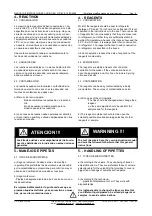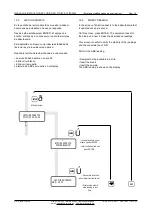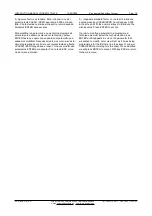
MANUAL DE INSTRUCCIONES CODIGO 80137 REV B 14/03/2008
(Sujetas a modi
fi
caciones sin previo aviso)
Pag.: 4
J.P. SELECTA
s.a.
Ctra. NII Km 585.1 Abrera 08630 (Barcelona) España
Tel 34 93 770 08 77 Fax 34 93 770 23 62
e-mail: [email protected] - http://www.jpselecta.es
ELECTROLITOS:
Son sustancias hidrosolubles que transportan cargas
eléctricas al estado libre. Cationes poseen carga positiva
mientras que los aniones carga negativa. Ejemplos: Ca
+2, K + , Na+ , CI-.
TIEMPO DE REACCIÓN
Para un sustrato: es el tiempo necesario para que toda
la sustancia a medir sea transformada químicamente en
una sustancia medible con el fotómetro. Para un enzima:
tiempo necesario para que el enzima pueda transformar
químicamente una cantidad de sustrato fotométricamente
cuanti
fi
cable.
TIEMPO DE INCUBACIÓN
Es el tiempo necesario para que comience la reacción en
las tecnicas cinéticas
TIEMPO DE ABSORCIÓN
Tiempo durante el cual la reacción se esta produciendo
en técnicas cinéticas.
3.-PREPARACIÓN DE LA MUESTRA
La sangre es el
fl
uido corporal más utilizado en el labora-
torio con
fi
nes analíticos.
Para la obtención de sangre, debe hacerse punción veno-
sa, evitando la hemólisis al máximo, utilizando agujas del
mayor calibre posible y realizando la extracción despacio.
Se mezcla la sangre con el anticoagulante mediante
movimientos de inversión moderados. En una extracción
venosa, la hemólisis puede ocasionarse frecuentemente
por estas causas:
-forzar el paso de la sangre al tubo.
-agitar el tubo enérgicamente.
-extraer sangre de un hematoma.
Si la muestra se hemoliza inter
fi
ere gravemente en los
resultados de hematocrito, eritrocitos, colesterol, los enzi-
mas, el hierro, etc.
3.1. CONSERVACIÓN DE LA SANGRE
Una vez extraída y mezclada con el anticoagulante se
deja reposar a temperatura ambiente 1 hora, para poste-
riormente refrigerar en nevera a 4°C si es necesario. No
se debe refrigerar la sangre que se vaya a utilizar para
obtener suero o plasma.
ELECTROLYTES:
They are substances hidrosolubles that transport electric
loads to the free state. Cationes have positive load while
the anions load negative. Examples: Ca +2, K +, Na+, CI
-.
REACTION TIME
It is the necessary time so that the whole substance to
measure is transformed chemically in an appraisable
substance with the photometer. For an enzyme:
necessary time so that the enzyme can made messurable
a quantity of sample.
INCUBATION TIME
It is the necessary time so that the chemical reaction
starts in the kinetic techniques
ABSORTION TIME
Time along when the chemical reaction is taking place in
technical kinetic.
3. - PREPARATION OF THE SAMPLE
The blood is the corporal
fl
uid more used in the laboratory
with analytic pourposes.
For the obtaining of blood, veined punción should be
made, avoiding the hemólisis, using needles of the
biggest possible caliber and carrying out the extraction
slowly. The blood is mixed with anticoagulant shaking
it slightly. In a veined extraction, the hemólisis can
frequently be caused by these causes:
Forzing the the blood to cross the tube.
Shaking the tube too vigorously.
Extracting blood from an hematoma.
If the sample becomes hemolized interferes dramticly
in the hematocrits results, eritrocitos, cholesterol, the
enzymes, the iron, etc.
3.1. BLOOD CONSERVATION
Once extracted and blended with the anticoagulant it is
left at temperature ambient for an 1 hour, and then stored
on to refrigerator at 4°C if it is necessary. The blood
should not be refrigerated that when it will be used to
obtain serum or plasma.





































